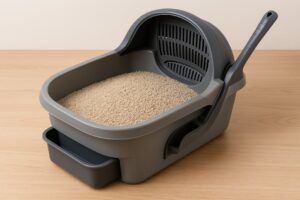
What Are Manual Self-Cleaning Litter Boxes?
Manual self-cleaning litter boxes are special boxes that help you clean your pet’s potty area without too much work. You just need to scoop or move a tray to get rid of the mess. They don’t need power or batteries to work.
Why Picking the Right Litter Box Is Important
Choosing the right litter box keeps your pet clean and healthy. A clean box helps stop bad smells and keeps germs away. It also helps your pet use the box every time, so they stay happy and feel safe.
Why This Guide Will Help You
This guide will help you learn all about these litter boxes, like how they work and which one might be best for you and your pet. By the end, you’ll know how to pick the perfect box to keep your pet happy and your home clean.
What Are Manual Self-Cleaning Litter Boxes?

Definition and Basic Concept
Manual self-cleaning litter boxes are special boxes where cats go potty. You don’t need to plug them in or use batteries. Instead, you do something simple, like rolling or tilting the box, to clean it. This helps keep the box fresh without much work.
Difference Between Manual and Automatic Litter Boxes
Manual litter boxes need you to help clean them by moving or shaking them. Automatic litter boxes do the cleaning by themselves using machines or timers. Manual boxes are cheaper and easier to take care of. Automatic ones are more expensive and need electricity or batteries to work.
| What They Do | Manual Litter Boxes | Automatic Litter Boxes |
| How They Work | You move or shake them | They clean by themselves |
| Price | Cheaper | More expensive |
| Care Needed | Easy | Harder, needs power |
| Needs Batteries? | No | Yes, or electricity |
| Lasts Long? | Yes | May need fixing |
| Easy to Use? | Pretty easy | Very easy |
How They Work: Step-by-Step Process
- Fill the Box: Pour some litter into the box.
- Cat Uses It: Your cat goes potty in the box.
- Clean the Box: You roll, tilt, or shake the box to clean it.
- Separate the Dirty Litter: The messy parts go into a special spot in the box.
- Throw Away the Mess: Take the dirty stuff out and throw it away.
- Add Fresh Litter: Put more litter in if you need to.
Benefits of Manual Self-Cleaning Litter Boxes
Clean and Healthy for Cats and People
Manual self-cleaning litter boxes help keep things clean. You can scoop the poop often, so it doesn’t get smelly or dirty. This helps keep cats and people safe and healthy, especially if someone has allergies.
Saves Money
Manual litter boxes are cheaper than fancy automatic ones. They don’t need batteries or electricity, so you don’t have to buy extra stuff. It’s a good choice if you want to save money and keep things clean.
Easy to Use and Clean
These litter boxes are super simple to use. They have trays or parts that make scooping easy. You don’t have to press buttons or set anything up, so it’s great for busy people. They last a long time and are easy to take care of.
Environmentally Friendly Options
Eco-friendly choices help take care of the Earth. They use safe materials, save energy, and can be reused or recycled. These ideas help make less trash and keep the air and water clean. Things like reusable bottles, paper bags, and toys made from plants are good for the planet. It’s all about using what’s safe and good for nature.
Enhanced Odor Control
Enhanced odor control means keeping bad smells away. Special tools and sprays help clean the air and make things smell fresh. They stop bad smells from coming back by cleaning the air really well. This helps people feel happy and keeps places smelling nice and clean.
Drawbacks of Manual Self-Cleaning Litter Boxes

Cleaning Takes Work
Manual litter boxes need people to clean them. You have to scoop, shake, or turn them to get the dirty litter out. You also have to dump the waste and put in fresh litter often. This can be hard to do, especially if you have lots of cats or are very busy.
Not as Fancy as Electric Ones
Manual litter boxes don’t have cool features like electric ones. They don’t clean themselves. You have to do all the work. No buttons, no sensors, no motors. You always have to clean them yourself.
Messy Mistakes Can Happen
When you clean a manual box, litter can spill everywhere. If you don’t do it right, the litter box can stay dirty and smell bad. It can be messy and tricky to keep it clean.
How Manual Self-Cleaning Litter Boxes Work

Manual self-cleaning litter boxes are like cat toilets that you have to clean by yourself. They don’t use batteries or plugs. You have to do the work to make them clean. You shake, turn, or scoop the litter to get the messy parts out. The dirty clumps go into a special spot, so you can throw them away later. You have to clean them often to keep them nice.
How They Work
Manual litter boxes need you to help clean them. You can turn, shake, or scoop the litter to take out the yucky parts. The dirty clumps go into a little bin so you can dump them out. They only work well if you clean them yourself all the time.
Different Types of Manual Litter Boxes
There are different kinds of manual litter boxes that work in different ways:
- Turning Boxes: You turn the box to move the litter around. The clumps fall into a tray so you can throw them away. Turning boxes are easy to use.
- Shaking Boxes: You shake the box or sift the litter to get rid of the dirty parts. Shaking can be messy if you’re not careful.
- Pulling Boxes: You pull a handle or lever to clean the litter. It puts the dirty clumps into a bin for you to throw away. This type is usually the cleanest and easiest to use.
All of these boxes work differently, but you always have to do the cleaning yourself.
What They All Have
Manual litter boxes usually have these things:
- Sifting Parts: Screens or trays that help you separate the clean litter from the yucky parts.
- Waste Bins: A little bin or tray where the messy parts go after you clean.
- No Electricity Needed: These boxes don’t need plugs or batteries, so they’re cheap to use.
- Strong Build: They’re made of tough stuff like strong plastic or metal, so they last a long time.
- Help with Smells: Some have covers or filters to keep bad smells inside.
These parts help you clean the box, but you still have to do it yourself.
What to Look For in a Cat Poop Box That Cleans Itself
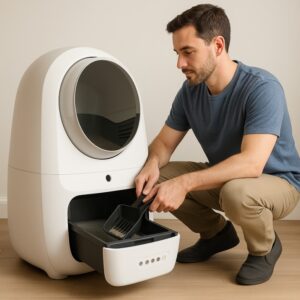
Picking the right litter box means finding one that’s easy to use, clean, and keeps bad smells away.
Strong and Lasting Materials
Choose a box made of tough plastic or metal. If it doesn’t scratch or break, it will last a long time and stay nice and clean.
Easy to Clean
Find a box that’s smooth and doesn’t have tiny spots where mess can get stuck. Boxes with trays you can pull out or parts you can wash are best. This makes cleaning easy and keeps it healthy.
Works with Different Kinds of Cat Litter
Make sure the box works with the litter you like. Some boxes work better with clumping or soft litter. Pick one that matches what you want to use.
Right Size for Your Cat
The box should be big enough for your cat to turn around and dig. If it’s too small, litter might spill out when your cat digs.
Helps Stop Bad Smells
Some boxes have filters or lids to trap bad smells. Boxes that let air move through them can also help keep smells away.
Easy to Put Together and Use
Pick a box that’s simple to put together. It should be easy to use so you don’t get frustrated trying to clean it.
When you find the right litter box, it’s easier for you and your cat to be happy.
How to Pick the Best Poop Box for Your Cat
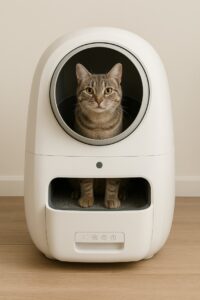
What Your Cat Likes
Look at your cat. Is your cat big or small? Is your cat young or old? Some cats like tall boxes. Some like boxes with no lid. Sick or old cats like boxes that are easy to get into. Try both kinds and see which one your cat likes best.
Your Budget
Some boxes cost a little. Some cost a lot. Pick one that you can pay for. Even if it is cheap, make sure it is strong and easy to clean. If you want a fancy box, make sure it works well.
Space You Have
Find a good spot for the box. Measure the space. Big boxes need big spots. Small spots need small boxes. Don’t hide the box in a place that is too tight or has no air. Cats like space and quiet.
Easy for You to Use
Pick a box that is easy to clean. Some have covers. Some clean themselves. Pick one that fits how you clean. If you are busy, a self-cleaning box may help you.
How to Set Up Your Cat’s New Poop Box
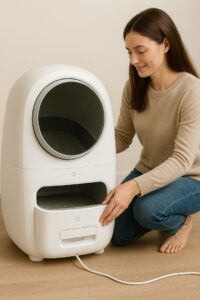
Steps to Set It Up
- Open the box. Make sure nothing is broken.
- Put the box together. Follow the paper guide.
- Add litter. Not too much. Not too little.
- Put the box in a quiet place. Not near loud stuff.
- Make sure all parts work right.
Helping Your Cat Use the New Box
Put the new box next to the old one. Put some old litter in the new box. Let your cat look and sniff. Give your cat treats when it uses the new box. Be kind and wait. If your cat does not like it, try again later.
Mistakes to Avoid
Don’t put the box in a loud or busy place. Don’t add too much or too little litter. Make sure the box is not broken or loose. Don’t use strong smells or sprays. Cats like clean and calm places. Don’t put too many boxes in the same place.
Best Manual Self-Cleaning Litter Boxes (2025 Edition)
1.Omega Paw EL-RA15-1 Elite Roll ‘n Clean Litter Box Regular
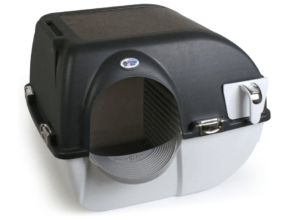
Here’s a simplified table Omega Paw Elite Roll ‘n Clean Self-Cleaning Litter Box (Regular):
| Feature | Details |
|---|---|
| Brand | Omega Paw |
| Model Name | Elite Roll ‘n Clean Self-Cleaning Litter Box |
| Model Number | EL-RA15-1 |
| Item Weight | 4.27 pounds |
| Dimensions (L×W×H) | 16.5 x 18.5 x 17 inches |
| Material | Plastic |
| Color | Midnight Black |
| Size | Regular |
| Country of Origin | Canada |
| ASIN | B07FG5J1RL |
| First Available | June 12, 2018 |
| Customer Reviews | 3.8 out of 5 stars (9,389 reviews) |
2.Omega Paw Elite Self-Cleaning Litter Box – Large, Midnight Black

Here’s a clean and concise product information table for the Omega Paw Elite Self-Cleaning Litter Box
| Feature | Details |
|---|---|
| Brand | Omega Paw |
| Model Number | EL-RA20-1 |
| Product Name | Omega Paw Elite Self-Cleaning Litter Box |
| Item Weight | 6.5 pounds |
| Dimensions (L×W×H) | 18.5 x 21.5 x 20 inches |
| Package Dimensions (L×W×H) | 22.9 x 20.34 x 10.66 inches |
| Material | Plastic |
| Color | Midnight Black |
| Size | Large |
| Target Audience | House-cats |
| Included Components | Top, Bottom, Sifting Grate, Waste Tray, Litter Step |
| Directions | Roll box over to sift waste into pull-out tray |
| Care Instructions | Wash with soap and water, clamp top and bottom tightly |
| Country of Origin | Canada |
| First Available | January 2, 2017 |
| Customer Reviews | ⭐⭐⭐⭐ (3.8 out of 5 from 13,276 reviews) |
| ASIN | B074L82WFD |
| Style | Elite |
| Age Range | All Stages |
| Warranty | 1 Year (Manufacturer defects with receipt) |
| Breed Recommendation | All Breed Sizes |
| Specific Uses | Litter |
3.Catit Smartsift Automatic Sifting Cat Litter Box

Here’s a clean, concise table Catit SmartSift Cat Litter Box:
| Feature | Details |
|---|---|
| Brand | Catit |
| Model Name | Catit SmartSift Cat Litter Box |
| Model Number | 50685 |
| Item Weight | 14.32 pounds |
| Dimensions (L×W×H) | 25.98 x 18.9 x 24.8 inches |
| Package Dimensions | 26.33 x 19 x 18 inches |
| Material | Plastic |
| Color | White/Gray |
| Size | 26″ L x 19″ W x 25″ H |
| Target Audience | House-cats |
| Specific Use | Indoor |
| Care Instructions | Hand Washable |
| Age Range | All Life Stages |
| Included Components | As listed in product description |
| Directions | Manual sifting system, no motor or electronics; max litter: 11 lbs / 305 cu in |
| Country of Origin | Malaysia |
| Language | English |
| Department | Litter Boxes |
| First Available | September 15, 2012 |
| Customer Reviews | ⭐⭐⭐ (3.3 out of 5 from 9,396 reviews) |
| ASIN | B009B83V76 |
| Style | Easy Cleaning |
4.Omega Paw Premium Roll ‘n Clean Litter Box Large,Cat, Peral Blue (PR-RA20-1)
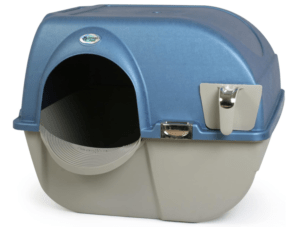
Sure! Here’s a simplified table Omega Paw Premium Litter Box Large:
| Feature | Details |
|---|---|
| Brand | Omega Paw |
| Model Name | Premium Litter Box Large |
| Model Number | PR-RA20-1 |
| Item Weight | 6.5 pounds |
| Dimensions (L×W×H) | 18.5 x 21.5 x 20 inches |
| Material | Polypropylene (PP) |
| Color | Pearl Blue |
| Size | Large |
| Country of Origin | Canada |
| ASIN | B0B25YNZYT |
| First Available | May 24, 2022 |
| Customer Reviews | 3.7 out of 5 stars (459 reviews) |
5.Omega Paw NRA15 Self Cleaning Litter Box Regular Size,Grey

Here is a simplified table Omega Paw New Improved Roll ‘n Clean Litter Box:
| Feature | Details |
|---|---|
| Brand | Omega Paw |
| Model Name | New Improved Roll ‘n Clean Litter Box |
| Model Number | NRA15-1 |
| Item Weight | 4.5 pounds |
| Dimensions (L×W×H) | 20 x 17.5 x 9 inches |
| Material | Plastic |
| Color | Grey |
| Size | Regular |
| Country of Origin | Canada |
| ASIN | B07DTJB854 |
| First Available | June 12, 2018 |
| Customer Reviews | 3.8 out of 5 stars (16,667 reviews) |
Keeping Your Litter Box Clean

Easy Ways to Clean Every Day, Week, and Month
Every Day: Scoop out the cat’s pee and poop with a little shovel. Make sure there is still enough clean litter for your kitty to dig in.
Every Week: Throw away all the litter. Wash the box with warm soapy water. Dry it all the way. Add fresh new litter when it’s clean.
Every Month: Look at the box to see if it’s broken. If something looks old or cracked, fix it or get a new one. Wash it really well.
How to Change Litter the Right Way
Scoop out the poop and clumps every day. When changing all the litter, wash the box and let it dry first. Use a good scoop to clean faster. Spread the litter flat so your cat can dig and cover easily.
Keeping Bad Smells Away
Pick litter that smells nice and makes good clumps. Clean the whole box when you change all the litter. Add a little baking soda to help with smells. Keep the box in a spot with fresh air, like near a window or fan.
Making Your Litter Box Last Longer
Check the box often to make sure nothing is broken. Clean it gently so it doesn’t get scratched. Don’t use strong, smelly cleaners. Replace old or broken parts when needed.
Fixing Common Problems
When It Gets Stuck
Clean the parts that move so they don’t get stuck. Don’t put too much litter inside. Look for little things stuck in the machine and take them out.
When It Doesn’t Separate Waste Right

Use the litter the box needs and not too much. Scoop poop and clumps every day. Fix the moving parts if they’re not working.
When Litter Doesn’t Work Right
Use the right kind of litter for your box. Don’t use litter that is too big or too tiny. Try other good litters if one doesn’t work.
When Your Cat Won’t Use It
Watch your cat to see why it doesn’t want the box. Put the box in a quiet place. Let your cat take time to get used to a new box.
Earth-Friendly Brands: Some brands make their boxes in ways that don’t hurt the Earth.
How to Help Your Cat Use a Litter Box
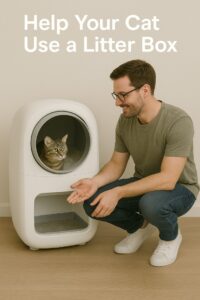
Show Your Cat the New Box
Put the new box next to the old one. Let your cat smell it and look at it. Don’t rush. Give your cat time. Cats like to feel safe, so talk to them softly while they explore. You can even play near the box so they feel happy being close to it.
Give a Treat
When your cat uses the new box, say “good job!” and give a treat or a cuddle. Always be kind. You can use a favorite toy too. Happy feelings help your cat feel good about using the box.
If Your Cat Doesn’t Like It
If your cat walks away, try moving the box to a quiet spot. Try soft litter that doesn’t smell too strong. Make sure the box is not near loud noises or busy spots. Some cats don’t like covered boxes, so try an open one instead.
Litter Boxes Help Keep Us Healthy

Stop Germs
Clean the litter box every day. This helps keep yucky germs away from you and your cat. Washing your hands after cleaning also keeps everyone safe. Using gloves can help too.
Keep the House Clean
A good box keeps mess in one spot. Less dust means clean air to breathe. Use a litter mat to stop litter from spreading. Keep a little broom nearby to sweep up fast.
Help With Allergies
Use soft litter with no smell and no dust. Clean the box a lot so the air stays fresh. Open a window or use a small fan to help blow away any smells or dust.
Manual vs. Automatic Litter Boxes
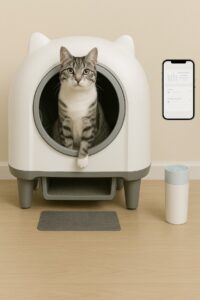
Which Costs More
Manual boxes cost less. You can find them at pet stores or even make one. Automatic boxes cost more money and can break if not used right.
Cleaning Time
Manual boxes need cleaning every day. You scoop the mess with your hand tool. Automatic boxes clean themselves but still need care. You must empty the waste bin and check the machine.
Easy to Use
Manual boxes are simple. Scoop by hand. You can see when it’s dirty. Automatic boxes are easier but can be noisy. Some cats may be scared of the sound.
Good for the Earth
Manual boxes don’t use power. They make less trash. Use eco litter to help the planet. You can also use old boxes as planters or storage.
Make Your Own Litter Box
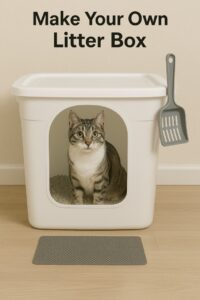
Good and Bad Things
Good: Making your own litter box costs less than buying one. You can choose the size to fit small or big cats and pick any color to match your room. It’s a fun craft for people who like to build things at home. You can also add parts like handles or rubber feet to make it better for your floor and easier to move.
Bad: Homemade litter boxes can break if the plastic is thin. If not sealed right, they may leak urine or let smells escape. Some may scratch your cat if edges are not smooth. Over time, they may need fixing or replacing. Cleaning may be harder if you don’t use a smooth, strong material.
What You Need
- A large, durable plastic storage bin (at least 15 inches wide and 10 inches tall)
- A scooper to clean out dirty litter daily
- Non-toxic glue (for sticking on parts if needed)
- A sharp utility knife or hole saw to make the cat’s entrance
- Optional: grip handles, rubber feet, or stickers for design
- Soft, fine-grit sandpaper to smooth the edges after cutting
- Measuring tape or ruler to keep cuts even
How to Make It
- Choose the Right Box: Find a plastic bin that’s strong, not too deep or shallow. It should fit in your home easily.
- Mark the Entrance: Use a marker to draw where the hole will go. A side entrance about 6 inches wide and 5 inches tall works for most cats.
- Cut Carefully: Use a sharp tool to cut the hole. Go slowly to avoid cracks. Adults should do this step.
- Smooth the Edges: Rub the hole’s edge with sandpaper until it feels soft. This keeps your cat safe.
- Add Extras: Stick on handles for lifting. Add rubber feet under the box so it stays in place. You can decorate with safe stickers.
- Add Litter: Pour in 2-3 inches of cat litter.
- Test with Your Cat: Let your cat sniff and try it. Watch how they act. If they don’t like it, change the size of the hole or the litter type.
Litter Boxes and the Earth
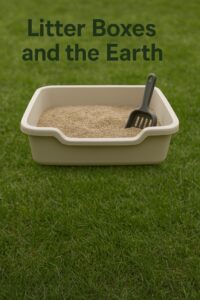
When we throw away plastic boxes or use synthetic litter, it can sit in landfills for hundreds of years. These materials don’t break down easily and can harm soil and water. Choosing eco-friendly materials helps protect nature.
Good Boxes for Nature
- Biodegradable Boxes: Made from natural materials like recycled paper, corn husks, or bamboo fibers. These boxes break down in compost or trash without polluting the ground.
- Reusable Boxes: Made from thick, long-lasting plastic or metal. These boxes don’t break easily. You can wash and reuse them for years.
- Eco-Conscious Brands: Some companies design litter boxes and packaging that use fewer chemicals and more recycled or natural materials. Look for brands that show eco-certifications.
Natural Litter
- Pine Litter: Made from compressed sawdust from pine trees. It smells fresh and controls odor naturally. Breaks down without chemicals.
- Wheat Litter: Comes from leftover wheat. It clumps well and is low-dust. Easy to scoop and safe for kittens.
- Corn Litter: Made from ground corn. It clumps and can go in compost piles (if allowed in your area). Breaks down fast in soil.
- Paper Litter: Soft, made from recycled newspaper or cardboard. Good for cats with allergies. Doesn’t make dust.
Use Less Plastic
- Washable Liners: Reusable fabric or rubber liners that can be cleaned instead of thrown out. Less waste over time.
- Bulk Litter: Buying one large bag instead of many small ones cuts down on packaging trash.
- Recyclable Materials: Look for the recycling symbol on boxes and packaging. Ask an adult to help sort and recycle.
Questions Kids Might Ask
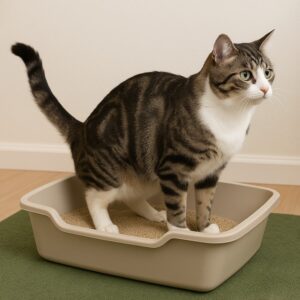
What kind of litter is best?
How often do I clean it?
Does it stop stinky smells?
Can little kittens and old cats use it?
How long will the box last?
What if it gets stuck?
What’s the difference between sifting and rolling boxes?
Rolling boxes: You roll the whole box on its side. The dirty litter rolls into a special part, so you can throw it away.
Are these boxes cheaper than electric ones?
Final Thoughts
What Did We Learn?
Manual litter boxes are easy to use, don’t cost much, and are good for the Earth. They don’t need electricity and help you clean up without much trouble.
How to Pick the Right One
Think about what your cat likes. Some cats like big boxes. Some like ones with covers. Make sure it’s easy for you to clean and safe for your cat to use.
One Last Thing
A nice litter box helps your cat feel happy. It also keeps your house clean and smelling fresh. Picking the right box means you and your cat both win!


Pingback: Perfect Litter Box for Maine Coon Cats - No More Mess